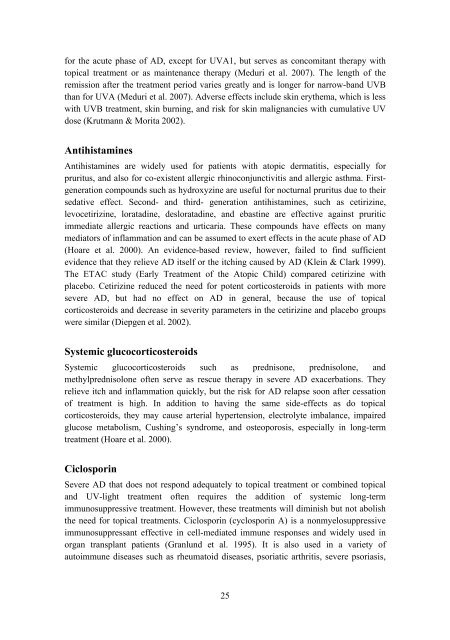Topical tacrolimus in atopic dermatitis: Effects of ... - Helda - Helsinki.fi
Topical tacrolimus in atopic dermatitis: Effects of ... - Helda - Helsinki.fi
Topical tacrolimus in atopic dermatitis: Effects of ... - Helda - Helsinki.fi
You also want an ePaper? Increase the reach of your titles
YUMPU automatically turns print PDFs into web optimized ePapers that Google loves.
for the acute phase <strong>of</strong> AD, except for UVA1, but serves as concomitant therapy with<br />
topical treatment or as ma<strong>in</strong>tenance therapy (Meduri et al. 2007). The length <strong>of</strong> the<br />
remission after the treatment period varies greatly and is longer for narrow-band UVB<br />
than for UVA (Meduri et al. 2007). Adverse effects <strong>in</strong>clude sk<strong>in</strong> erythema, which is less<br />
with UVB treatment, sk<strong>in</strong> burn<strong>in</strong>g, and risk for sk<strong>in</strong> malignancies with cumulative UV<br />
dose (Krutmann & Morita 2002).<br />
Antihistam<strong>in</strong>es<br />
Antihistam<strong>in</strong>es are widely used for patients with <strong>atopic</strong> <strong>dermatitis</strong>, especially for<br />
pruritus, and also for co-existent allergic rh<strong>in</strong>oconjunctivitis and allergic asthma. Firstgeneration<br />
compounds such as hydroxyz<strong>in</strong>e are useful for nocturnal pruritus due to their<br />
sedative effect. Second- and third- generation antihistam<strong>in</strong>es, such as cetiriz<strong>in</strong>e,<br />
levocetiriz<strong>in</strong>e, loratad<strong>in</strong>e, desloratad<strong>in</strong>e, and ebast<strong>in</strong>e are effective aga<strong>in</strong>st pruritic<br />
immediate allergic reactions and urticaria. These compounds have effects on many<br />
mediators <strong>of</strong> <strong>in</strong>flammation and can be assumed to exert effects <strong>in</strong> the acute phase <strong>of</strong> AD<br />
(Hoare et al. 2000). An evidence-based review, however, failed to f<strong>in</strong>d suf<strong>fi</strong>cient<br />
evidence that they relieve AD itself or the itch<strong>in</strong>g caused by AD (Kle<strong>in</strong> & Clark 1999).<br />
The ETAC study (Early Treatment <strong>of</strong> the Atopic Child) compared cetiriz<strong>in</strong>e with<br />
placebo. Cetiriz<strong>in</strong>e reduced the need for potent corticosteroids <strong>in</strong> patients with more<br />
severe AD, but had no effect on AD <strong>in</strong> general, because the use <strong>of</strong> topical<br />
corticosteroids and decrease <strong>in</strong> severity parameters <strong>in</strong> the cetiriz<strong>in</strong>e and placebo groups<br />
were similar (Diepgen et al. 2002).<br />
Systemic glucocorticosteroids<br />
Systemic glucocorticosteroids such as prednisone, prednisolone, and<br />
methylprednisolone <strong>of</strong>ten serve as rescue therapy <strong>in</strong> severe AD exacerbations. They<br />
relieve itch and <strong>in</strong>flammation quickly, but the risk for AD relapse soon after cessation<br />
<strong>of</strong> treatment is high. In addition to hav<strong>in</strong>g the same side-effects as do topical<br />
corticosteroids, they may cause arterial hypertension, electrolyte imbalance, impaired<br />
glucose metabolism, Cush<strong>in</strong>g’s syndrome, and osteoporosis, especially <strong>in</strong> long-term<br />
treatment (Hoare et al. 2000).<br />
Ciclospor<strong>in</strong><br />
Severe AD that does not respond adequately to topical treatment or comb<strong>in</strong>ed topical<br />
and UV-light treatment <strong>of</strong>ten requires the addition <strong>of</strong> systemic long-term<br />
immunosuppressive treatment. However, these treatments will dim<strong>in</strong>ish but not abolish<br />
the need for topical treatments. Ciclospor<strong>in</strong> (cyclospor<strong>in</strong> A) is a nonmyelosuppressive<br />
immunosuppressant effective <strong>in</strong> cell-mediated immune responses and widely used <strong>in</strong><br />
organ transplant patients (Granlund et al. 1995). It is also used <strong>in</strong> a variety <strong>of</strong><br />
autoimmune diseases such as rheumatoid diseases, psoriatic arthritis, severe psoriasis,<br />
25

















